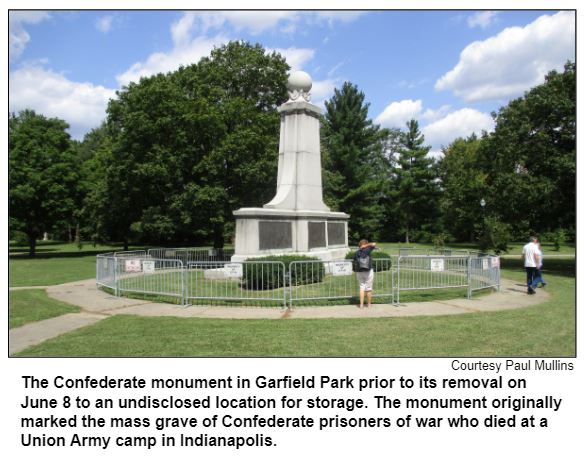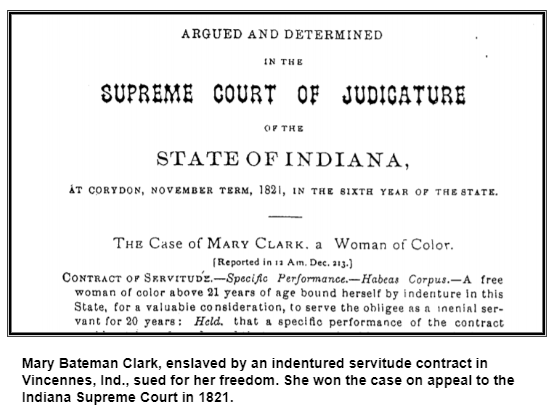
Saturdays, noon to 1 p.m. ET on WICR 88.7 FM.
Or stream audio live from anywhere on WICR Online!
You can listen to recent shows by clicking the podcast links below, or check out our extensive archive of past shows available as podcasts.
June 27, 2020
Confederate monument in Indy and Camp Morton
Following the recent dismantling in an Indianapolis park of a Confederate monument that originally marked the graves of prisoners of war who died at a Union Army camp, Hoosier History Live will explore the historic context of various aspects of the controversy.
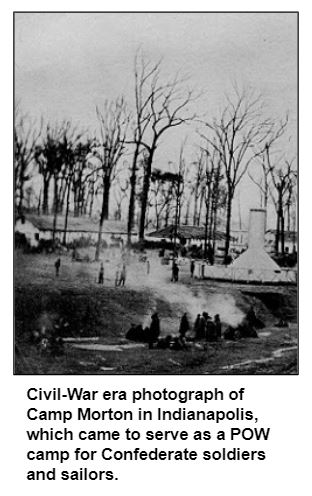
Civil War historian Steve Towne, the author of Surveillance and Spies in the Civil War (Ohio University Press) and other books and award-winning articles about the Civil War, is an archivist at IUPUI. His colleague Paul Mullins, an anthropology professor, has researched the Confederate monument, which he notes was placed initially at Greenlawn Cemetery in 1909.
Greenlawn, the first major public cemetery in Indianapolis, was located near the White River and Kentucky Avenue, a site that was prone to flooding and later became increasingly industrialized. The monument, funded by the federal government, was a mass marker for 1,616 Confederate POWs whose remains could not be identified individually. Their remains were moved to Crown Hill Cemetery, Greenlawn's successor as the city's major graveyard; the reburial site at Crown Hill is known as Confederate Mound. According to Paul Mullins, the POWs' remains were reburied at Confederate Mound in 1931.
Along with Steve Towne and Paul Mullins, our guests during the show will include Ophelia Wellington, founder of Freetown Village, a living history museum she created in 1982 to teach African-American history.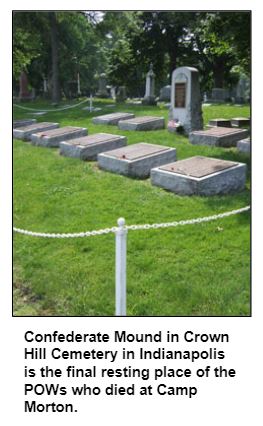
During the course of the war, Camp Morton primarily served as a POW camp for Confederate soldiers and sailors; by the end of the war, about 1,700 had died there. Today, much of the Herron-Morton Place Neighborhood is on the site of Camp Morton.
With the moves of the POWs' remains, many could not be identified. The relocation of the federally-funded monument (with a metal plate at the base that lists the names of the POWs) from Greenlawn to Garfield Park was advocated by the Southern Club of Indianapolis, which Paul Mullins will describe during our show.
The placement of the monument in a public park in the late 1920s has been controversial for several years. Since the June 8 dismantling, it has been stored at an undisclosed location.
It is not the only Confederate monument, memorial or marker in Indiana. According to the Indiana Historical Bureau, a state historic marker in the Franklin County town of Laurel, birthplace of a Confederate brigadier general, is under review for "misleading and inaccurate statements" as well as the lack of proper historic context on the signage. In Terre Haute, an obelisk at Woodlawn Cemetery memorializes eleven Confederates who died in a POW camp in the city.
The phone lines will be opened earlier than usual during our show for listeners' questions and comments.
Nelson Price, host and historian
Molly Head, producer/general manager, (317) 927-9101
Mick Armbruster, associate producer
Cheryl Lamb, administrative manager
Richard Sullivan, senior tech consultant
Pam Fraizer, graphic designer
Garry Chilluffo, consultant
Please tell our sponsors that you appreciate their support!

 For organizational sponsorship, which includes logos, links, and voiced credits in the show and in podcasts, email support@hoosierhistorylive.org, or call (317) 927-9101 for information. Our podcast listens are increasing at a rate of 17% a month and we are being distributed on Indiana Memory and the National Digital Public Library. As we have always believed, the internet distribution of Hoosier History Live is taking us to the top! Thanks also to Visit Indy, Fraizer Designs, WICR-FM, Henri Pensis, Aaron Duvall, Kielynn Tally, Justin Clark, and many other individuals and organizations.
For organizational sponsorship, which includes logos, links, and voiced credits in the show and in podcasts, email support@hoosierhistorylive.org, or call (317) 927-9101 for information. Our podcast listens are increasing at a rate of 17% a month and we are being distributed on Indiana Memory and the National Digital Public Library. As we have always believed, the internet distribution of Hoosier History Live is taking us to the top! Thanks also to Visit Indy, Fraizer Designs, WICR-FM, Henri Pensis, Aaron Duvall, Kielynn Tally, Justin Clark, and many other individuals and organizations.
Thank you!
We'd like to thank the following recent, new and renewal contributors whose donations help make this show possible!
- Linda Gugin and Jim St. Clair
- Doug Winnings
- Peggy Sabens
- Carl and Kathleen Widland
- Carol Bacon
- Rachel Perry
- Tom Swenson
- Dr. James Madison
- Stacia Gorge
- Dr. Geoffrey Golembiewski
- Clarke Kahlo
- Jim and Nancy Johnson
- Marion Wolen
- Robin Winston
July 4, 2020 - coming up
Racial justice in 1820s Indiana: Slave trial and Fall Creek Massacre - encore
With various aspects of racial justice in the headlines, Hoosier History Live will explore precedent-setting legal trials in early Indiana involving African Americans and Native Americans. We are drawing upon our rich archive for a special encore show focusing on two landmark cases of racial justice in early 19th century Indiana.

In 1821, Mary Bateman Clark, a young African-American woman living in Vincennes, made history when her lawyer filed a lawsuit seeking her release from an "indentured servitude" contract with one of the most prominent men in the new state of Indiana. The contract required Clark to cook, clean and sew for Gen. Washington Johnston and his family for 20 years. Her only pay was housing, food and clothing.
The case, which made its way to the Indiana Supreme Court, involved determining whether such "indentured servitude" contracts violated the state's Constitution as a form of slavery. Nearly 200 years ago - on Nov. 16, 1821 - the state Supreme Court ruled in Clark's favor and ordered her employer to release her.
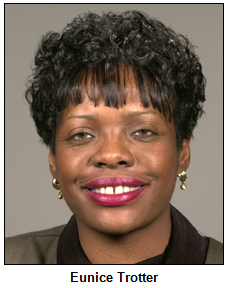 Sharing insights about the social history of the era and the landmark case, Nelson is joined in studio by one of Clark's descendants, Indianapolis resident Eunice Trotter. Eunice, a veteran journalist, and her sister Ethel McCane have used their research about their ancestor to do "living history performances" for schools and civic groups across the state.
Sharing insights about the social history of the era and the landmark case, Nelson is joined in studio by one of Clark's descendants, Indianapolis resident Eunice Trotter. Eunice, a veteran journalist, and her sister Ethel McCane have used their research about their ancestor to do "living history performances" for schools and civic groups across the state.
Eunice and Ethel also crusaded for a historic marker in honor of Mary Bateman Clark, which was dedicated at the Knox County Courthouse in 2009. The sisters are Mary Bateman Clark's great-great-great granddaughters.
Nelson and his guest also discuss a similar case involving another young woman, Polly Strong, who also lived in Vincennes in the 1820s and sued to obtain her freedom. She had been enslaved by Col. Hyacinth LaSalle, a prominent Vincennes resident, before Indiana became a state in 1816. LaSalle challenged the new state Constitution, unsuccessfully arguing that it could not be applied retroactively.
Re-enactments of the Polly Strong case have been performed across Indiana under the direction of Corydon historic preservationist Maxine Brown, who has been a guest on Hoosier History Live for a show about her historic restoration of a segregated school in Corydon, as well as a show discussing DNA testing and family ancestry. The restored school, now known as the Leora Brown School, has been the setting for re-enactments of the court cases of Mary Bateman Clark and Polly Strong.
Just three years after the Mary Bateman Clark trial, another milestone Indiana legal case set a precedent for racial justice in the United States.
When white men were found guilty by a jury and executed for the slaughter of nine Native Americans in March 1824, it was the first time that the murders of Indians by whites had been subject to capital punishment under American law.
 To explore all aspects of the brutal crimes in the swampy woods of Madison County - where the Native Americans (including three women and four children) were gruesomely murdered - Nelson is joined in studio by David Thomas Murphy, author of the book, Murder in Their Hearts: The Fall Creek Massacre (Indiana Historical Society Press).
To explore all aspects of the brutal crimes in the swampy woods of Madison County - where the Native Americans (including three women and four children) were gruesomely murdered - Nelson is joined in studio by David Thomas Murphy, author of the book, Murder in Their Hearts: The Fall Creek Massacre (Indiana Historical Society Press).
A professor of history at Anderson University, David spent four years researching the massacre, trial and subsequent developments, including the social history of pioneer Hoosiers (Indiana only had been a state for about seven years at the time of the massacre) and of the Native Americans in the region.
"The slaughter in the soggy Indiana creek bottoms created a short-lived but serious national security crisis," David has written, referring to concerns across the country that warfare would erupt across newly developing states.
In researching the tragedy, David explored why the federal government devoted great effort and resources to prosecuting the perpetrators. David's research required that he reconcile conflicting accounts of the events (the tribal origins of some of the victims remain unclear) as well as the motivations involved in the cold-blooded crimes, which involved shooting some of the Native Americans in their backs and mutilating several of the corpses.
© 2020 Hoosier History Live. All rights reserved.
|
